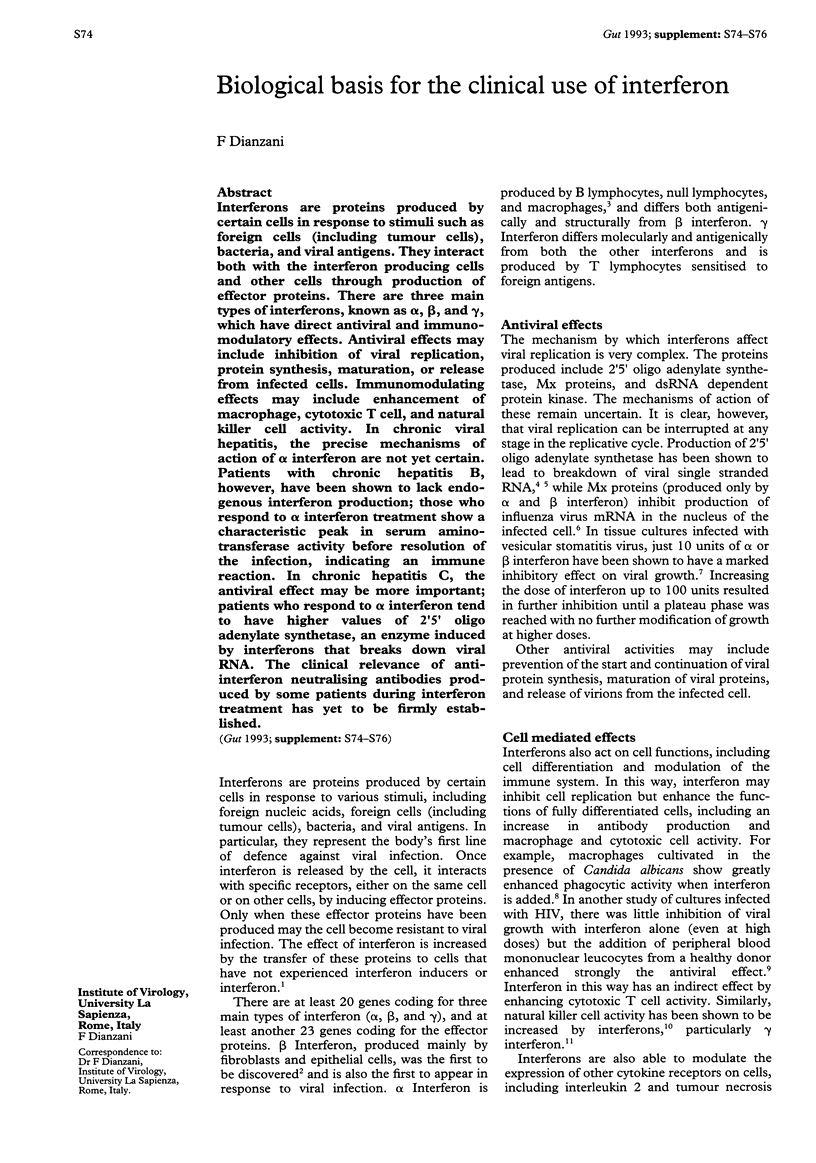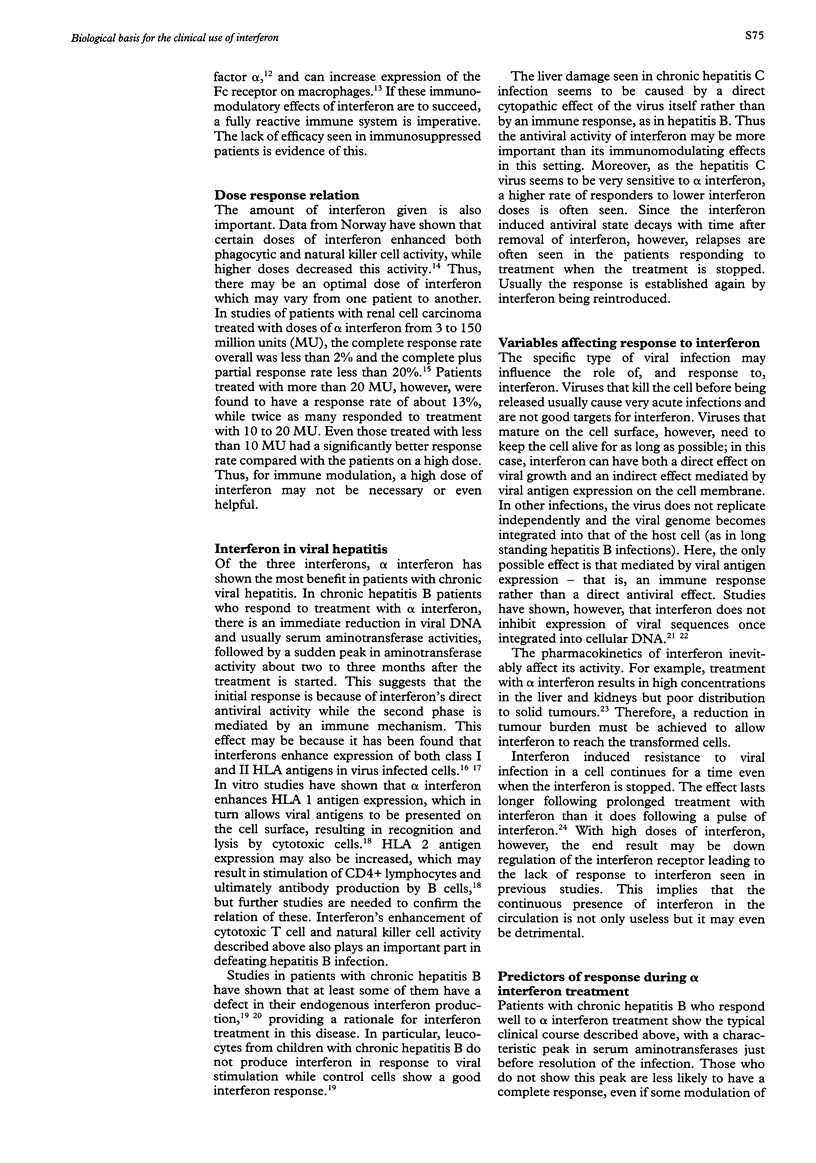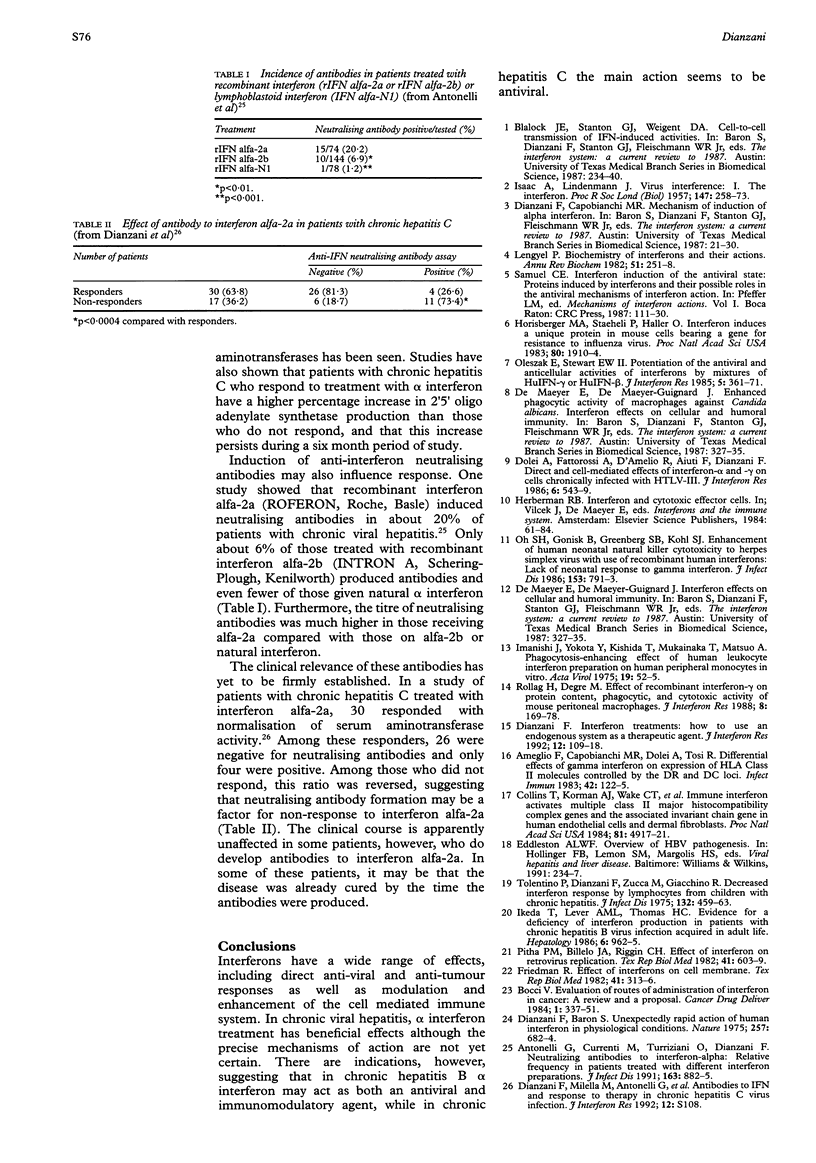Abstract
Interferons are proteins produced by certain cells in response to stimuli such as foreign cells (including tumour cells), bacteria, and viral antigens. They interact both with the interferon producing cells and other cells through production of effector proteins. There are three main types of interferons, known as alpha, beta, and gamma, which have direct antiviral and immunomodulatory effects. Antiviral effects may include inhibition of viral replication, protein synthesis, maturation, or release from infected cells. Immunomodulating effects may include enhancement of macrophage, cytotoxic T cell, and natural killer cell activity. In chronic viral hepatitis, the precise mechanisms of action of alpha interferon are not yet certain. Patients with chronic hepatitis B, however, have been shown to lack endogenous interferon production; those who respond to alpha interferon treatment show a characteristic peak in serum amino-transferase activity before resolution of the infection, indicating an immune reaction. In chronic hepatitis C, the antiviral effect may be more important; patients who respond to alpha interferon tend to have higher values of 2'5' oligo adenylate synthetase, an enzyme induced by interferons that breaks down viral RNA. The clinical relevance of anti-interferon neutralising antibodies produced by some patients during interferon treatment has yet to be firmly established.
Full text
PDF


Selected References
These references are in PubMed. This may not be the complete list of references from this article.
- Ameglio F., Capobianchi M. R., Dolei A., Tosi R. Differential effects of gamma interferon on expression of HLA class II molecules controlled by the DR and DC loci. Infect Immun. 1983 Oct;42(1):122–125. doi: 10.1128/iai.42.1.122-125.1983. [DOI] [PMC free article] [PubMed] [Google Scholar]
- Antonelli G., Currenti M., Turriziani O., Dianzani F. Neutralizing antibodies to interferon-alpha: relative frequency in patients treated with different interferon preparations. J Infect Dis. 1991 Apr;163(4):882–885. doi: 10.1093/infdis/163.4.882. [DOI] [PMC free article] [PubMed] [Google Scholar]
- Bocci V. Evaluation of routes of administration of interferon in cancer: a review and a proposal. Cancer Drug Deliv. 1984 Fall;1(4):337–351. doi: 10.1089/cdd.1984.1.337. [DOI] [PubMed] [Google Scholar]
- Collins T., Korman A. J., Wake C. T., Boss J. M., Kappes D. J., Fiers W., Ault K. A., Gimbrone M. A., Jr, Strominger J. L., Pober J. S. Immune interferon activates multiple class II major histocompatibility complex genes and the associated invariant chain gene in human endothelial cells and dermal fibroblasts. Proc Natl Acad Sci U S A. 1984 Aug;81(15):4917–4921. doi: 10.1073/pnas.81.15.4917. [DOI] [PMC free article] [PubMed] [Google Scholar]
- Dianzani F., Baron S. Unexpectedly rapid action of human interferon in physiological conditions. Nature. 1975 Oct 23;257(5528):682–684. doi: 10.1038/257682a0. [DOI] [PubMed] [Google Scholar]
- Dianzani F. Interferon treatments: how to use an endogenous system as a therapeutic agent. J Interferon Res. 1992 May;Spec No:109–118. doi: 10.1089/jir.1992.1992.109. [DOI] [PubMed] [Google Scholar]
- Dolei A., Fattorossi A., D'Amelio R., Aiuti F., Dianzani F. Direct and cell-mediated effects of interferon-alpha and -gamma on cells chronically infected with HTLV-III. J Interferon Res. 1986 Oct;6(5):543–549. doi: 10.1089/jir.1986.6.543. [DOI] [PubMed] [Google Scholar]
- Friedman R. M. Effects of interferons on cell membranes. Tex Rep Biol Med. 1981;41:313–316. [PubMed] [Google Scholar]
- Horisberger M. A., Staeheli P., Haller O. Interferon induces a unique protein in mouse cells bearing a gene for resistance to influenza virus. Proc Natl Acad Sci U S A. 1983 Apr;80(7):1910–1914. doi: 10.1073/pnas.80.7.1910. [DOI] [PMC free article] [PubMed] [Google Scholar]
- ISAACS A., LINDENMANN J. Virus interference. I. The interferon. Proc R Soc Lond B Biol Sci. 1957 Sep 12;147(927):258–267. doi: 10.1098/rspb.1957.0048. [DOI] [PubMed] [Google Scholar]
- Ikeda T., Lever A. M., Thomas H. C. Evidence for a deficiency of interferon production in patients with chronic hepatitis B virus infection acquired in adult life. Hepatology. 1986 Sep-Oct;6(5):962–965. doi: 10.1002/hep.1840060525. [DOI] [PubMed] [Google Scholar]
- Imanishi J., Yokota Y., Kishida T., Mukainaka T., Matsuo A. Phagocytosis-enhancing effect of human leukocyte interferon preparation of human peripheral monocytes in vitro. Acta Virol. 1975 Jan;19(1):52–58. [PubMed] [Google Scholar]
- Lengyel P. Biochemistry of interferons and their actions. Annu Rev Biochem. 1982;51:251–282. doi: 10.1146/annurev.bi.51.070182.001343. [DOI] [PubMed] [Google Scholar]
- Oh S. H., Gonik B., Greenberg S. B., Kohl S. Enhancement of human neonatal natural killer cytotoxicity to herpes simplex virus with use of recombinant human interferons: lack of neonatal response to gamma interferon. J Infect Dis. 1986 Apr;153(4):791–793. doi: 10.1093/infdis/153.4.791. [DOI] [PubMed] [Google Scholar]
- Oleszak E., Stewart W. E., 2nd Potentiation of the antiviral and anticellular activities of interferons by mixtures of HuIFN-gamma and HuIFN-alpha or HuIFN-beta. J Interferon Res. 1985 Spring;5(2):361–371. doi: 10.1089/jir.1985.5.361. [DOI] [PubMed] [Google Scholar]
- Pitha P. M., Bilello J. A., Riggin C. H. Effect of interferon on retrovirus replication. Tex Rep Biol Med. 1981;41:603–609. [PubMed] [Google Scholar]
- Rollag H., Degré M. Effect of recombinant interferon-gamma on protein content, phagocytic, and cytotoxic activity of mouse peritoneal macrophages. J Interferon Res. 1988 Apr;8(2):169–178. doi: 10.1089/jir.1988.8.169. [DOI] [PubMed] [Google Scholar]
- Tolentino P., Dianzani F., Zucca M., Giacchino R. Decreased interferon response by lymphocytes from children with chronic hepatitis. J Infect Dis. 1975 Oct;132(4):459–461. doi: 10.1093/infdis/132.4.459. [DOI] [PubMed] [Google Scholar]


